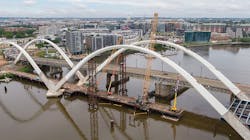NO. 3 BRIDGE: New Frederick Douglass Memorial Bridge
About 16 years ago, the District Department of Transportation embarked on a journey to rebuild the Frederick Douglass Memorial Bridge (FDMB).
After 68 years of serving residents from and surrounding the District of Columbia, it was declared “structurally deficient and functionally obsolete,” and in need of a rebuild. This would become the largest public infrastructure project in the history of the District.
Some of the design challenges the team faced included working with the arch base connection. Unlike typical steel to concrete connections, which utilize a base plate that is external to the section, all parts of the anchorage for FDMB are internal to the arch section. This layout created several design issues which needed to be considered and overcome including stiffener/anchor rod layout, edge spalling effects, baseplate details and fabrication, and coordination with v-pier post tensioning detailing.
The steel arches span unbraced over the deck to create a dramatic design. The hexagonal shape of the arches casts shadows and decreases the visual mass of the arch. The design and analysis of such a unique shape brought about many challenges. The team utilized global and localized 3-D models to fully analyze the behavior of the arches. Because of the unique shape, the steel arch rib required stiffening in various locations on the top flange, bottom flange, top web, and bottom web, that were not consistent throughout the arch.
The V-pier substructure allows the arch form to transfer smoothly to the foundations. While the arch induces compression into the V-pier legs, the tangent shape of the legs means that large moments do occur that created several design challenges. The construction of these massive V-piers necessitated large falsework to be built on temporary pile supports. The falsework supported the custom formwork that created the tapering hexagonal shape.
The smaller approach roadways and other urban core elements made for challenging logistics. The foundations of the New FDMB were supported by 60-in.-diam. x 1-in. wall thickness by 100-ft-long pipe pile that had to be spliced on-site due to permitting windows and fees not allowing them to traverse the city streets’ full length.
Many of the arch pieces were more than 80,000 lb and due to their shape, it required extensive coordination with many state agencies to secure the arches’ safe arrival from the Wisconsin fabrication facility.
The contractor, South Capitol Bridgebuilders (SCB), used a series of ground improvement methodologies (grouted columns and piers, continuous flight auger piles), structural support slabs, and lightweight fills to meet project settlement and loading criteria. Additionally, the specialty geotechnical contractor stabilized the soil in two areas, which eliminated the settlement period and allowed the MSE walls to be designed without added settlement considerations.
“This project is extra special because it is the first bridge in our Nation’s Capital (a city of arch bridges) with arches that extend above the deck—highly visible by land, water, and air,” Dennis Howland II, P.E., program manager for the District Department of Transportation, told Roads & Bridges. “The FDMB is more than just a beautiful bridge, it is the product of a grand vision, more than a decade of planning and preparation, and years of hard work and dedication. It is an example of what can be done when politicians, professionals, and laborers unite.”
Both the structural steel and full-depth precast deck panels had extensive lead times. The progression of the design would require that final drawings for the steel and precast deck panels would not be complete for 12 months from notice to proceed. The structural steel fabricator then required 12 months to generate shop drawings, fabricate, and deliver the first arch pieces. While the precast panels were not as complex as the structural steel, the panels required a mandatory 180-day cure period from the time of casting to incorporation into the structure. This challenge was overcome with intense coordination with the suppliers, frequent schedule and piece mark delivery updates, and working two shifts per day to install the materials when they arrived on site.
